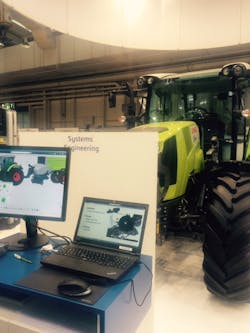As manufacturers look to streamline production in the connected world of Industry 4.0, suppliers are stepping up with integrated design and programming tools that synchronize various phases of the process—from ideation to engineering and the shop floor.
There were many examples demonstrating the move to concurrent engineering at Hannover Messe last week. The focus was on digitalization to unite different engineering disciplines thereby saving time, money and improving overall product quality.
One company in particular, however, is delivering the ultimate digital factory experience. It is called the 3DExperience from Dassault Systèmes. Operating as a single, visual environment, the technology provides virtual mapping of conception, design, simulation, configuration and production in a uniform platform with one log-in and unique user interfaces into applications.
The company, rooted in computer-aided design (CAD) software, has spent the last decade acquiring a wide variety of companies specializing in everything from modeling and simulation software to search-based applications and integrated dashboards to manufacturing operations management (MOM), product lifecycle management (PLM) and supply chain planning. Just two years ago all of the integration was complete, and last week, Dassault showcased a customer example to demonstrate how it works.
CLAAS, an agricultural equipment manufacturer, used 3DExperience to design and build its next-generation tractor that includes embedded intelligent control systems to provide more energy-efficient machines that accomplish more while keeping farmers’ operational costs to a minimum.
Using the 3DExperience, CLAAS designers around the world have access to a single source of product data on a need-to-know basis, for more security from unauthorized access. Product information is the same for everyone, which avoids errors that can occur when the wrong design is used. Mechanical, electrical and hydraulics engineers have simultaneous access to designs and can work concurrently instead of in a sequential manner.
Specifically, the various stages of the interconnected process includes:
Ideation- Using social and collaborative apps, the 3DExperience platform serves as a cockpit for information, providing configurable dashboards to present insights and overviews of the ideation process.
Additive Manufacturing- The program leverages 3D printing to create fully functional parts. The process chain shows the topology optimization of the part, the generation of a bionic lattice structure, the processing of a 3D print model and the setup of the NC program, including instructions to the machine or workstation.
Configurator- This provides the handling and modeling implementation rules to prevent and eliminate faults and errors. Part lists are created simultaneously.
Systems Engineering- From the definition of requirements to the design of the mechatronic product, this function secures collaboration between mechanics, electronics and software development. The Requirements, Functional, Logical, Physical (RFLP) framework is the foundation to represent all aspects of the system model.
NC and Robot Programming- Reuse of program modules. Once a similar part is found, the NC program is overtaken and optimized for the new situation, saving time, programming costs and avoiding errors. Custom parts can be created fast by versatile apparatus combined with a scalable robot program.
Virtual Build- Production of variants in an industrial process means precise planning of upstream or semi-finished products. Through the manufacturing bill of materials (BOM), the engineering design goes into the assembly sequence and then into the manufacturing steps.
Shop Floor- The advantages of digitization go right through to the workstation on the shop floor. The digital master for work instructions and NC or robot programs flow into a simulation workplace in which the digital model for assembly is generated, and an assembly workstation where the digital model is enhanced by current information and then finalized for production.
The 3DExperience is based on objects—not files—to handle large amounts of data, as well as digitizing everything that relates to the product, thereby synchronizing all aspects of development.
“We are tearing down the walls between engineering, manufacturing and service,” said Philippe Bartissol, vice president of industrial equipment industry at Dassault Systèmes, noting that a service component will soon be added into the mix that includes an “as-maintained” BOM of every piece of equipment in the field.
While the digital factory often focuses on data, the 3DExperience business platform not only organizes information but recognizes the people working with it, said Bartissol, so that knowledge and expertise can be utilized across an organization to drive innovation.

